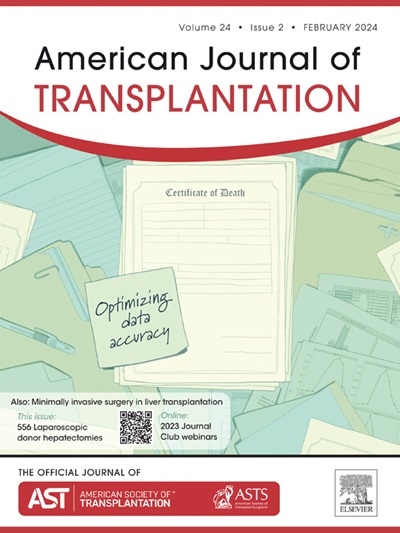肺气肿单肺移植与双肺移植的存活率比较。
IF 8.2
2区 医学
Q1 SURGERY
引用次数: 0
摘要
双侧肺移植(BLT)与单肺移植(SLT)的益处仍然存在争议。临床推荐的一个障碍是BLT与SLT的优势可能因潜在疾病而异。由于这两种选择在肺气肿患者中都是可行的,因此我们对这一人群的同种异体肺移植存活率进行了全面评估。使用美国注册数据,我们研究了2006年至2022年间8092例12岁及以上移植患者的全因同种异体移植失败时间,通过逆倾向加权调整受体、供体和移植因素。BLT的中位同种异体移植生存期为6.6年,SLT为5.3年,经风险调整后的生存期优势为0.81.31.8年,为25%。在11个亚组中,风险调整后的双侧生存优势在0.9至2.4年之间变化。同种异体移植在BLT中的中位生存期比右侧SLT长1.2年,比左侧SLT长2.0年。在16年的研究期间,BLT的同种异体移植物存活率稳步提高,而SLT则没有。尽管25%的BLT生存优势在大流行之前就存在,但COVID-19可能导致SLT生存明显下降。认识到由于选择偏差导致的残留混杂可能的影响,这些发现可能有助于在两个供体肺都可用时提供决策。本文章由计算机程序翻译,如有差异,请以英文原文为准。
Graft survival in single versus bilateral lung transplantation for emphysema
The benefits of bilateral lung transplantation (BLT) vs single lung transplantation (SLT) are still debated. One impediment to clinical recommendations is that BLT vs SLT advantages may vary based on underlying disease. Because both options are clinically tenable in patients with emphysema, we conducted a comprehensive assessment of lung allograft survival in this population. Using US registry data, we studied time to all-cause allograft failure in 8092 patients 12 years or older, transplanted from 2006 to 2022, adjusting for recipient, donor, and transplant factors by inverse propensity weighting. Median allograft survival was 6.6 years in BLT compared to 5.3 years in SLT, a 25% risk-adjusted survival advantage of 0.81.31.8 years. Risk-adjusted bilateral survival advantages varied between 0.9 and 2.4 years across 11 subgroups. Median allograft survival in BLT was 1.2 years greater than right SLT and 2.0 years greater than left SLT. During the 16-year study period, allograft survival steadily improved for BLT but not for SLT. Although the 25% BLT survival advantage predated the coronavirus 2019 (COVID-19) pandemic, COVID-19 may have contributed to an apparent SLT survival decline. Recognizing the possible influence of residual confounding due to selection biases, these findings may aid offer decision-making when both donor lungs are available.
求助全文
通过发布文献求助,成功后即可免费获取论文全文。
去求助
来源期刊
CiteScore
18.70
自引率
4.50%
发文量
346
审稿时长
26 days
期刊介绍:
The American Journal of Transplantation is a leading journal in the field of transplantation. It serves as a forum for debate and reassessment, an agent of change, and a major platform for promoting understanding, improving results, and advancing science. Published monthly, it provides an essential resource for researchers and clinicians worldwide.
The journal publishes original articles, case reports, invited reviews, letters to the editor, critical reviews, news features, consensus documents, and guidelines over 12 issues a year. It covers all major subject areas in transplantation, including thoracic (heart, lung), abdominal (kidney, liver, pancreas, islets), tissue and stem cell transplantation, organ and tissue donation and preservation, tissue injury, repair, inflammation, and aging, histocompatibility, drugs and pharmacology, graft survival, and prevention of graft dysfunction and failure. It also explores ethical and social issues in the field.

 求助内容:
求助内容: 应助结果提醒方式:
应助结果提醒方式:


